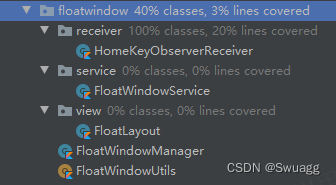Android Kotlin系统悬浮窗
Swuagg 人气:0Android 弹窗浅谈
我们知道 Android 弹窗中,有一类弹窗会在应用之外也显示,这是因为他被申明成了系统弹窗,除此之外还有2类弹窗分别是:子弹窗与应用弹窗。
应用弹窗:就是我们常规使用的 Dialog 之类弹窗,依赖于应用的 Activity;子弹窗:依赖于父窗口,比如 PopupWindow;系统弹窗:比如状态栏、Toast等,本文所讲的系统悬浮窗就是系统弹窗。
系统悬浮窗具体实现
权限申请
<uses-permission android:name="android.permission.SYSTEM_ALERT_WINDOW" /> <uses-permission android:name="android.permission.SYSTEM_OVERLAY_WINDOW" />
代码设计
下面的包结构截图,简单展示了实现系统悬浮窗的代码结构,更复杂的业务需要可在此基础上进行扩展。

FloatWindowService:系统悬浮窗在此 Service 中弹出;
FloatWindowManager:系统悬浮窗管理类;
FloatLayout:系统悬浮窗布局;
HomeKeyObserverReceiver:
监听 Home 键;
FloatWindowUtils:系统悬浮窗工具类。
具体实现
FloatWindowService 类
class FloatWindowService : Service() {
private val TAG = FloatWindowService::class.java.simpleName
private var mFloatWindowManager: FloatWindowManager? = null
private var mHomeKeyObserverReceiver: HomeKeyObserverReceiver? = null
override fun onCreate() {
TLogUtils.i(TAG, "onCreate: ")
mFloatWindowManager = FloatWindowManager(applicationContext)
mHomeKeyObserverReceiver = HomeKeyObserverReceiver()
registerReceiver(mHomeKeyObserverReceiver, IntentFilter(Intent.ACTION_CLOSE_SYSTEM_DIALOGS))
mFloatWindowManager!!.createWindow()
}
override fun onBind(intent: Intent?): IBinder? {
return null
}
override fun onStartCommand(intent: Intent?, flags: Int, startId: Int): Int {
return START_NOT_STICKY
}
override fun onDestroy() {
TLogUtils.i(TAG, "onDestroy: ")
mFloatWindowManager?.removeWindow()
if (mHomeKeyObserverReceiver != null) {
unregisterReceiver(mHomeKeyObserverReceiver)
}
}
}
FloatWindowManager 类
包括系统悬浮窗的创建、显示、销毁(以及更新)。
public void addView(View view, ViewGroup.LayoutParams params); // 添加 View 到 Window public void updateViewLayout(View view, ViewGroup.LayoutParams params); //更新 View 在 Window 中的位置 public void removeView(View view); //删除 View
FloatWindowManager 类代码
class FloatWindowManager constructor(context: Context) {
var isShowing = false
private val TAG = FloatWindowManager::class.java.simpleName
private var mContext: Context = context
private var mFloatLayout = FloatLayout(mContext)
private var mLayoutParams: WindowManager.LayoutParams? = null
private var mWindowManager: WindowManager = context.getSystemService(Context.WINDOW_SERVICE) as WindowManager
fun createWindow() {
TLogUtils.i(TAG, "createWindow: start...")
// 对象配置操作使用apply,额外的处理使用also
mLayoutParams = WindowManager.LayoutParams().apply {
type = if (Build.VERSION.SDK_INT >= Build.VERSION_CODES.O) {
// Android 8.0以后需要使用TYPE_APPLICATION_OVERLAY,不允许使用以下窗口类型来在其他应用和窗口上方显示提醒窗口:TYPE_PHONE、TYPE_PRIORITY_PHONE、TYPE_SYSTEM_ALERT、TYPE_SYSTEM_OVERLAY、TYPE_SYSTEM_ERROR。
WindowManager.LayoutParams.TYPE_APPLICATION_OVERLAY
} else {
// 在Android 8.0之前,悬浮窗口设置可以为TYPE_PHONE,这种类型是用于提供用户交互操作的非应用窗口。
// 在API Level = 23的时候,需要在Android Manifest.xml文件中声明权限SYSTEM_ALERT_WINDOW才能在其他应用上绘制控件
WindowManager.LayoutParams.TYPE_PHONE
}
// 设置图片格式,效果为背景透明
format = PixelFormat.RGBA_8888
// 设置浮动窗口不可聚焦(实现操作除浮动窗口外的其他可见窗口的操作)
flags = WindowManager.LayoutParams.FLAG_NOT_FOCUSABLE
// 调整悬浮窗显示的停靠位置为右侧置顶
gravity = Gravity.TOP or Gravity.END
width = 800
height = 200
x = 20
y = 40
}
mWindowManager.addView(mFloatLayout, mLayoutParams)
TLogUtils.i(TAG, "createWindow: end...")
isShowing = true
}
fun showWindow() {
TLogUtils.i(TAG, "showWindow: isShowing = $isShowing")
if (!isShowing) {
if (mLayoutParams == null) {
createWindow()
} else {
mWindowManager.addView(mFloatLayout, mLayoutParams)
isShowing = true
}
}
}
fun removeWindow() {
TLogUtils.i(TAG, "removeWindow: isShowing = $isShowing")
mWindowManager.removeView(mFloatLayout)
isShowing = false
}
}
FloatLayout 类及其 Layout
系统悬浮窗自定义View:FloatLayout
class FloatLayout @JvmOverloads constructor(context: Context, attrs: AttributeSet? = null, defStyleAttr: Int = 0, defStyleRes: Int = 0) :
ConstraintLayout(context, attrs, defStyleAttr, defStyleRes) {
private var mTime: TCLTextView
private var mDistance: TCLTextView
private var mSpeed: TCLTextView
private var mCalories: TCLTextView
init {
val view = LayoutInflater.from(context).inflate(R.layout.do_exercise_view_float_layout, this, true)
mTime = view.findViewById(R.id.float_layout_tv_time)
mDistance = view.findViewById(R.id.float_layout_tv_distance)
mSpeed = view.findViewById(R.id.float_layout_tv_speed)
mCalories = view.findViewById(R.id.float_layout_tv_calories)
}
}
布局文件:float_layout_tv_time
HomeKeyObserverReceiver 类
class HomeKeyObserverReceiver : BroadcastReceiver() {
override fun onReceive(context: Context?, intent: Intent?) {
try {
val action = intent!!.action
val reason = intent.getStringExtra("reason")
TLogUtils.d(TAG, "HomeKeyObserverReceiver: action = $action,reason = $reason")
if (Intent.ACTION_CLOSE_SYSTEM_DIALOGS == action && "homekey" == reason) {
val keyCode = intent.getIntExtra("keycode", KeyEvent.KEYCODE_UNKNOWN)
TLogUtils.d(TAG, "keyCode = $keyCode")
context?.stopService(Intent(context, FloatWindowService::class.java))
}
} catch (ex: Exception) {
ex.printStackTrace()
}
}
companion object {
private val TAG = HomeKeyObserverReceiver::class.java.simpleName
}
}
FloatWindowUtils 类
object FloatWindowUtils {
const val REQUEST_FLOAT_CODE = 1000
private val TAG = FloatWindowUtils::class.java.simpleName
/**
* 判断Service是否开启
*/
fun isServiceRunning(context: Context, ServiceName: String): Boolean {
if (TextUtils.isEmpty(ServiceName)) {
return false
}
val myManager = context.getSystemService(Context.ACTIVITY_SERVICE) as ActivityManager
val runningService = myManager.getRunningServices(1000) as ArrayList<ActivityManager.RunningServiceInfo>
runningService.forEach {
if (it.service.className == ServiceName) {
return true
}
}
return false
}
/**
* 检查悬浮窗权限是否开启
*/
@SuppressLint("NewApi")
fun checkSuspendedWindowPermission(context: Activity, block: () -> Unit) {
if (commonROMPermissionCheck(context)) {
block()
} else {
Toast.makeText(context, "请开启悬浮窗权限", Toast.LENGTH_SHORT).show()
context.startActivityForResult(Intent(Settings.ACTION_MANAGE_OVERLAY_PERMISSION).apply {
data = Uri.parse("package:${context.packageName}")
}, REQUEST_FLOAT_CODE)
}
}
/**
* 判断悬浮窗权限权限
*/
fun commonROMPermissionCheck(context: Context?): Boolean {
var result = true
if (Build.VERSION.SDK_INT >= 23) {
try {
val clazz: Class<*> = Settings::class.java
val canDrawOverlays = clazz.getDeclaredMethod("canDrawOverlays", Context::class.java)
result = canDrawOverlays.invoke(null, context) as Boolean
} catch (e: Exception) {
TLogUtils.e(TAG, e)
}
}
return result
}
}
总结
本文并未详细讨论系统悬浮窗的拖动功能,实现系统悬浮穿基本功能可以总结为以下几个步骤:
1. 声明及申请权限;
2. 构建悬浮窗需要的控件 Service、Receiver、Manager、Layout、Util;
3. 使用 WindowManager 创建、显示、销毁(以及更新)Layout。
加载全部内容